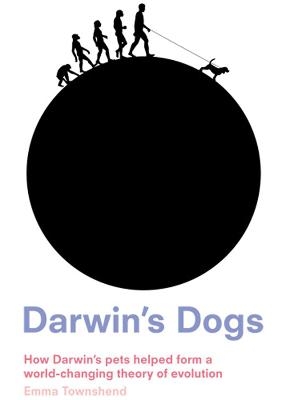
Darwin's Dogs
Frances Lincoln (Verlag)
978-0-7112-3065-1 (ISBN)
- Titel ist leider vergriffen;
keine Neuauflage - Artikel merken
Anyone who has ever looked at a dog waiting to go for a walk and thought there was something age-old and almost human in its sad expression can take comfort in knowing that Charles Darwin did exactly the same thing. But Darwin didn’t just stop at feeling that there was some connection between humans and dogs. A great naturalist, pioneer of the theory of evolution, and incurable dog-lover, Darwin used his much-loved dogs as evidence in his continuing argument that all animals, including human beings, descended from one common ancestor. Emma Townshend looks at Darwin’s life through a uniquely canine perspective, from his fondly written letters home inquiring after the health of family pets to his profound scientific consideration of the ancestry of the domesticated dog. Vintage photographs of dogs, together with modern diagrams, help show the visual aspects of the evolutionary theory.
Emma Townshend has degrees in history and history of science from Cambridge, Imperial College and UCL, and her postgraduate thesis involved research about Darwin's correspondence with plant breeders and gardeners. She has taught courses on Darwin since being a postgraduate at Cambridge in 1994, most recently for the Department of Continuing Education in Oxford, and was particularly involved in Oxford's online course project ?All learn', run in cooperation with Stanford and Yale, for which she wrote a course under the aegis of Richard Dawkins.She has recently written on Darwin's connections with the Royal Botanic Garden for Kew Magazine, and will be giving special guided tours of Kew in Darwin's bicentenary year, 2009. A regular guest on radio and TV including the World Service, Radio 4 Womans' Hour, A Hard Act to Follow, and BBC2 Newsnight, Emma Townshend is the Independent on Sunday's weekly garden columnist and writes regularly for the Times' arts pages.
Chapter 1: Beginnings 'You care for nothing but shooting, dogs, and rat-catching, and you will be a disgrace to yourself and all your family.' This chapter would give a short history of Darwin's childhood, his upbringing and education, and his early influences. It would show how he grew up surrounded by dogs and dog breeders. The chapter would look at how ideas about pedigree breeding may have influenced his early thoughts. (The chapter would also look at the Voyage of the Beagle.) Chapter 2: Mechanisms 'One out of every hundred litters is born with long legs, and in the Malthusian rush for life, only two of them live to breed. If prey are swift the long-legged one shall rather oftener survive ... in ten thousand years the long-legged race will get the upper hand.' Darwin began to formulate his theory on his return from the Beagle voyage, and he drew particularly on Malthus and Lyell who were two of his most important intellectual influences. From these two thinkers he developed his sense of the length of time over which evolution took place, and the huge fecundity of nature compared to the small numbers of surviving organisms. This chapter would look in particular at his early researches, corresponding with dog, pigeon and vegetable breeders, trying to find real-life examples which would prove his controversial theory. Chapter 3: Problems 'Did you ever see black Grey-hound (of any sub-breed) with tan feet, & a tan-coloured spot over inner corner of each eye; I want such case, & such must exist because theory tells me it ought!' Darwin knew there were many problems with his theory: not just religious objections, but also scientific ones. This chapter will show how he attempted to face such possible objections head on, immersing himself in detailed cataloguing of how varieties might evolve into species, spending twenty years overall refining his early theory. Chapter 4: Origins 'With respect to the colouring of domestic dogs, I at one time hoped might have thrown some light on their origin.' In 1858 Darwin received the alarming news that Alfred Russel Wallace had developed a parallel theory of evolution. He was galvanised into action and the Origin of Species appeared in 1859, its first chapter devoted to domesticated animals and plants, its entire text full of canine examples. This chapter would look at the Origin in detail, examining both what it did, and did not say (crucially, and despite all myths to the contrary, it did not touch on the issue of human origins). Chapter 5: Similarities 'A dog frames a general concept of cats or sheep, and knows the corresponding words as well as a philosopher.' It was only ten years after the publication of the Origin in 1859 that Darwin dared to publish on the controversial subject of human evolution. In 'The Descent of Man', dogs featured more centrally than ever before. Dogs and apes are used repeatedly to prove how very few of human beings' 'unique' characteristics are actually unique. His wonderful writing on the subject of dogs will be much-quoted in this chapter, showing how he believed them to be one of the most advanced creatures alive bar human beings. Chapter 6: Predictions 'I can believe almost anything about them.' Darwin's entire career is interwoven with his relationship with dogs. In this chapter we'd look at the predictions Darwin made, and examine how they have been proven to be correct using the latest genetic techniques as well as animal behaviour experiments.
| Erscheint lt. Verlag | 5.11.2009 |
|---|---|
| Zusatzinfo | 20 B&W photos |
| Sprache | englisch |
| Maße | 130 x 197 mm |
| Gewicht | 293 g |
| Themenwelt | Sachbuch/Ratgeber ► Natur / Technik ► Tiere / Tierhaltung |
| Naturwissenschaften ► Biologie ► Allgemeines / Lexika | |
| Naturwissenschaften ► Biologie ► Evolution | |
| Schlagworte | Biologische Evolution • Darwin, Charles |
| ISBN-10 | 0-7112-3065-X / 071123065X |
| ISBN-13 | 978-0-7112-3065-1 / 9780711230651 |
| Zustand | Neuware |
| Haben Sie eine Frage zum Produkt? |
aus dem Bereich


